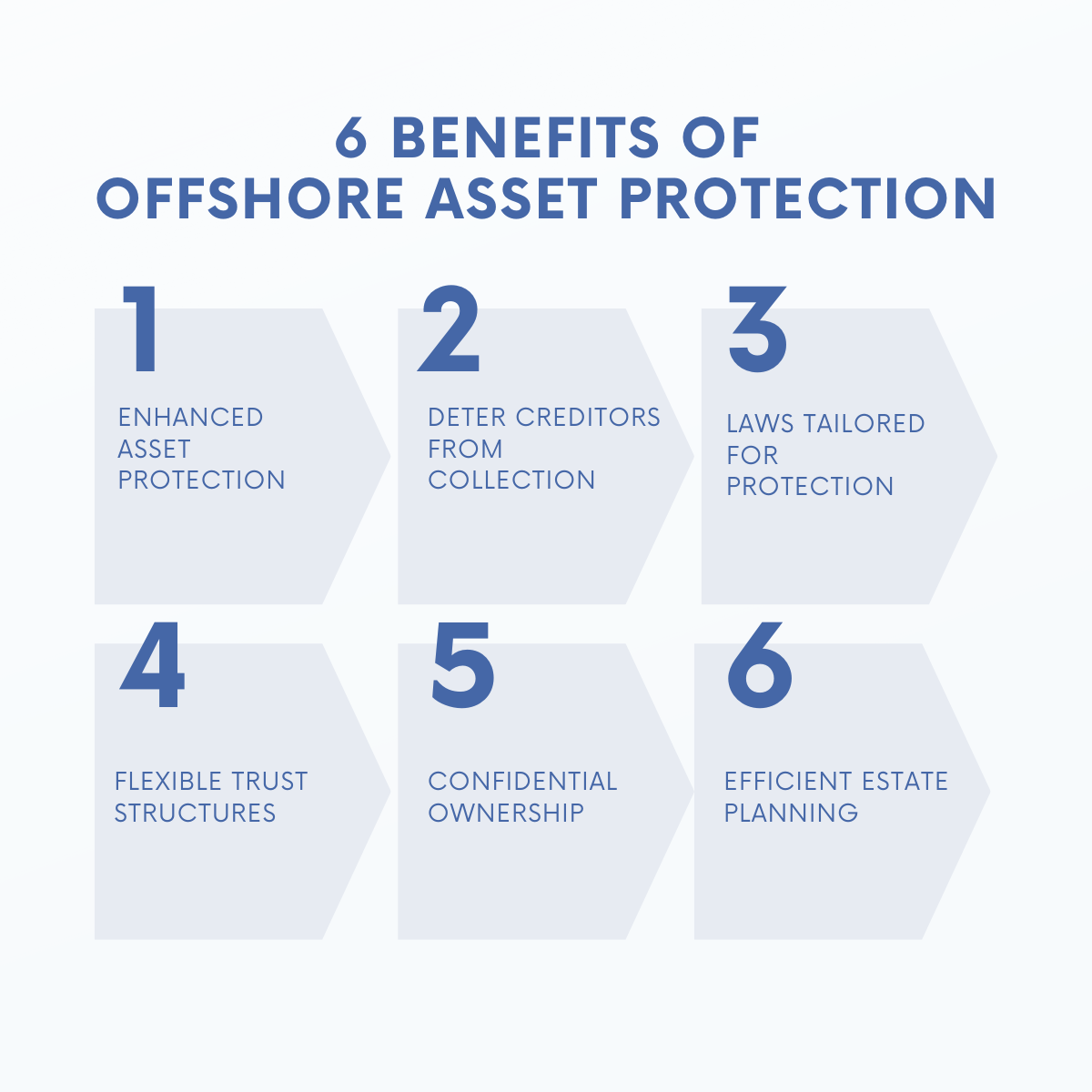An offshore asset protection trust is a legal arrangement in which a trust is established in a foreign jurisdiction that does not recognize judgments from the United States.
This type of trust is used to shield assets from current creditors and protect wealth from potential lawsuits.
How Does an Offshore Asset Protection Trust Work?
The first step to setting up an offshore asset protection trust is to transfer the assets into the trust. The trust is managed by a trustee located in the foreign country.
The trust operates under the laws of the chosen foreign jurisdiction. The trustee is bound by the trust’s terms. The trustee manages and distributes the assets according to the grantor’s instructions.
Since the assets are legally owned by the trust and not the individual, it becomes more challenging for creditors or legal entities to claim them.
For judgment creditors to reach assets in an offshore asset protection trust, a creditor must start over and institute a lawsuit against the defendant to establish a new judgment in the foreign court system.
While the grantor can specify the terms of management and beneficiaries, they should retain limited or no control over the assets to ensure the trust’s effectiveness in protecting assets from legal claims and creditors.
Tip: In our experience, an offshore asset protection trust is one of the best asset protection techniques for our clients with significant assets.
Benefits of Offshore Asset Protection
The main reason most people pursue offshore asset protection is to take assets outside the reach of domestic creditors. Offshore asset protection trusts are one the go-to asset protection tools recommended by asset protection attorneys.
Offshore asset protection is not just useful for the wealthy. Even people with modest net worth can use offshore asset protection to protect their assets from lawsuits, creditors, and other legal claims.
One key advantage of using an offshore asset protection trust is that favorable offshore jurisdictions have a short statute of limitations on fraudulent transfer claims. While most states have a four-year statute of limitations, offshore trusts are subject to only two years.

Best Jurisdictions for Offshore Asset Protection
Several jurisdictions are renowned for making it difficult for judgment creditors to collect. These jurisdictions include the Cook Islands, Nevis, the Cayman Islands, and Belize.
The best jurisdiction for an offshore asset protection trust is the Cook Islands. It has the most favorable asset protection laws in the world. It is most effective and safest offshore asset protection jurisdiction.
The Cook Islands have a long history of favorable case law that provides legal assurance that a U.S. debtor’s assets will be well protected under its laws.
We help protect your assets from creditors.
We give customized advice to clients nationwide. Get answers from our attorneys by phone or Zoom.

Steps to Establish an Offshore Asset Protection Trust
To create an offshore asset protection trust, you start by consulting with an attorney in the United States to select a foreign jurisdiction and trustee company. Next, you draft the trust document, specifying the terms, beneficiaries, and duties of the trustee. Finally, you transfer assets into the trust to officially fund it.
How Is an Offshore Asset Protection Trust Taxed?
Offshore asset protection trusts are taxed as grantor trusts.
Any offshore asset protection requires IRS tax filings to report and disclose the ownership of foreign entities and money held, directly or indirectly, in foreign bank accounts, such as a Swiss bank account. The tax filings are informational, and offshore asset protection planning does not reduce or increase U.S. income tax liability.
Any type of offshore asset protection is complicated because of IRS reporting requirements applicable to foreign entities. People considering offshore asset protection should consult with a tax attorney or a CPA experienced in international tax law.
Failure to comply with foreign entity reporting requirements carries severe penalties. The tax reporting requirements are one reason we usually try to accomplish asset protection with domestic tools under Florida exemptions before recommending more sophisticated offshore entities.
People also read about…
Frequently Asked Questions
Here are our answers to some common questions we receive from our clients about offshore asset protection trusts.
What does offshore asset protection do?
Offshore asset protection involves moving assets to foreign jurisdictions with favorable laws to shield them from potential creditors or legal claims. It typically uses trusts or business entities in countries with strong privacy laws and debtor-friendly regulations, aiming to make assets more difficult for others to access or seize.
How much does an offshore asset protection trust cost?
A typical offshore asset protection trust plan costs between $15,000 and $30,000. More complicated situations will cost more.
How long does it take to set up an offshore asset protection plan?
About 2-3 months. You have to develop the plan with an attorney, file an application with the offshore trust company, complete a background check, sign the trust documents, and then transfer the assets to the offshore trust.
How safe is offshore asset protection?
Offshore asset protection is safe if you choose a reputable, licensed, and insured trustee company. Your attorney can help you pick the best country and trustee company for your situation.
Is offshore asset protection legal?
Yes, offshore asset protection is legal. Unless there is an injunction prohibiting you from transferring your assets, it is not a crime to transfer your assets to an offshore trust.








